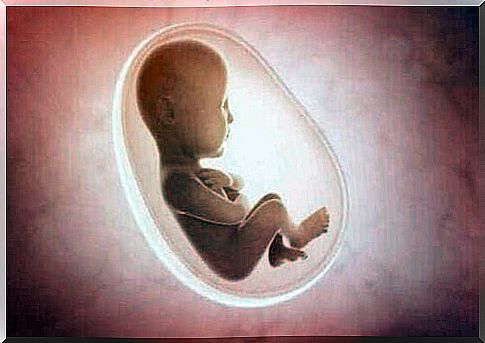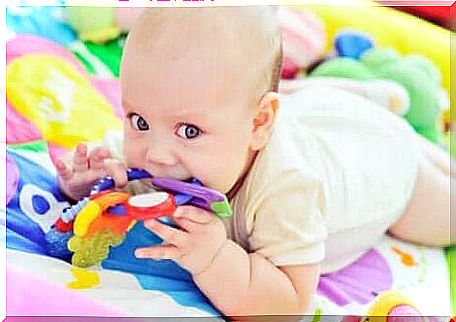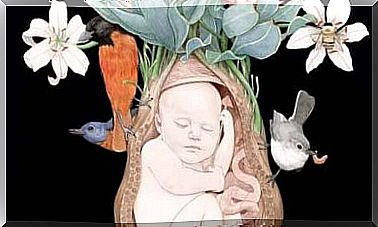The Sensory Development Of Unborn And Newborn

During the 40 weeks that children grow in the womb, the sensory development goes at full speed. Not only are they busy developing physically in order to function in the world around them, but they also perceive the world around them from a very early gestational age.
This fascinating process forms the basis of the child’s early attachment to his mother. Not surprisingly, the uterus is the perfect environment for fetal development.
The development of the mind during pregnancy plays a crucial role in the development of the brain in the womb. In today’s article, we will explain which senses develop first in the fetus. You may be surprised at what you learn!

The sensory development of the feeling
Emotion is the first sensation in a fetus that develops in the womb, starting as early as around week eight. The feeling of touch begins with sensory receptors on the face, mainly in the lips and nose.
In the next few months, the tactile receptors will also begin to develop in other parts of the body. At about 12 weeks, the palms and soles of the feet develop these receptors. When the fetus is 17 weeks old, the receptors in the abdomen develop.
At about 12 weeks, the fetus can already experience sensation all over the body. The exception is the top of the head, which is insensitive to touch until birth.
Interestingly, brain scans indicate that the fetus cannot register various specific forms of sensory impressions until about 30 weeks. This is when the somatosensory neural pathways are fully developed. But in the middle of the third trimester, the baby can experience a large number of different emotions, including heat, cold and pressure.
The sensory development of taste and smell
Taste and smell are closely linked; your taste is actually 90 percent odor. Studies show that certain flavors, such as vanilla, carrot, garlic, anise and mint, are actually transmitted through the amniotic fluid.
Taste
During the period in the womb, the taste buds only appear at about eight weeks. Between 13 and 15 weeks, the fetus already has taste buds similar to adults. Everything that the mother eats while the baby is in the womb penetrates amniotic fluid and the baby swallows it.
Smell
The sense of smell develops together with the sense of taste. From the moment a baby is born, it can identify its mother only through the sense of smell if required. The baby can also easily identify the unique smell of the mother’s breast milk.
In fact, if you place a baby on its mother immediately after it is born, it will twist and bulge up to the nipple, controlled by the smell of the colostrum. This is called “breast crawling”.
Hearing
The auditory system is fully developed after 20 weeks. At about 23 weeks, the baby may react to loud noises.
Infants can also learn to identify the voices they hear in the womb. If the sense of hearing develops normally, loud noises will frighten the fetus. Newborns also have a tendency to prefer higher voices, as in their mothers, than deeper voices, as in their fathers.
A 2014 study of premature babies showed that it was enough to play a recording of the mother’s voice while the children sucked on a pacifier to improve the oral feeding ability and shorten the hospital stay.
Sight
Life in the womb is usually dark, but human skin still allows some light to pass through. Researchers have found that fetuses are twice as likely to track the movement of light patterns that look like human faces. They have also seen the same pattern and preference in newborns.
This suggests that the preference for human faces may be innate and not just the result of experiences that occur after birth. It is also a clear sign that the fetus reacts actively to the outside world long before it leaves the uterus.
The vision in newborns
Newborn babies are extremely myopic; they can only see things up to about 15 inches from their faces.
They cannot see colors as we see them as adults and they cannot identify shapes until they are six months old. Newborn eyes are sensitive to bright light, which causes them to close their eyes to avoid it. After a month, newborns can see colors but they often prefer to look at black and white pictures and toys.
At about seven months, most children have reached a mature vision. They also have the hand-eye coordination and depth perception they need to have to reach toys out of their immediate reach. Their focus gets better over the next two to three years as their eyes mature and they can see more and more clearly.

The sensory development after birth
Evidence for early sensory development in the uterus opens up the possibility of stimulating the fetus during pregnancy. The choices a pregnant mother makes about what she should eat and what kind of music she should play can affect her unborn baby in a surprising way.
That being said, a significant portion of sensory development occurs after the baby is born. Consequently, the most effective sensory stimulation is that which infants receive after birth when it is then also accompanied by a cognitive development.









